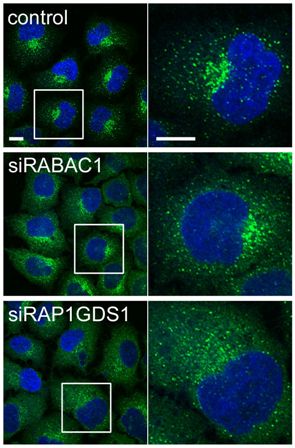Secretion processes in human cells controlled by 15% of proteins encoded by human genome
4 June 2012
An international collaboration between University College Dublin and the European Molecular Biology Laboratory (EMBL) has revealed for the first time that 15% of the proteins encoded by the human genome contribute to the process of secretion in cells.
Science has long recognised that secretion is a fundamental process, essential to almost all cell types in the body. The process is used to deliver hormones into the blood stream, digestive enzymes into the gut, and signalling molecules between cells.
However, until now, technology did not permit scientists to catalogue the complex pathway that a protein or lipid takes from manufacture to packaging and transporting through the cell to being secreted from the cell.
“This study is the first genome-wide assessment of the secretory process in a human cell system”, explains Professor Jeremy Simpson, UCD School of Biology & Environmental Science and UCD Conway Institute, co-author of the research paper published online today in Nature Cell Biology.
“Previous studies on the secretory process have either been carried out with a more narrow focus on specific subsets of genes or in more simplistic organisms such as the fruit fly (Drosophila) where many of the proteins identified have no human equivalent. Now, using high content screening, we have been able to systematically target each of the 22,000 human genes and track the journey of a specific, fluorescently-tagged protein as it travels through, and out of, over 8 million individual cells.”
“In order for us to understand the impact on the body when this fundamental process of secretion is disrupted, we must first decipher the functional network of membrane trafficking pathways within the cell.”
The researchers analysed more than 700,000 microscopy images and found 554 proteins that influence secretion, with 143 of these either influencing the early stage of the secretory pathway or morphology of the Golgi, a cellular structure responsible for packaging and labelling proteins.

Photo caption: In cells where different genes are silenced (middle, bottom), the site where the secretory processes begins (green) changes compared to normal cells (top)’
Membrane traffic pathways connect membrane bound organelles in a carefully ordered sequence that ensures the correct complement of proteins and lipids within the cell exist in order to maintain cellular balance or homeostasis.
Newly synthesised proteins and lipids in the endoplasmic reticulum (ER) are modified as they pass along the secretory pathway through the Golgi apparatus to the cell surface.
The secretory pathway has the capacity to cope with a wide variety of cargo molecules, and as such utilises extensive regulatory machinery in the process. This study focuses on particular regulatory elements in the early stage of the pathway called the cytoplasmic coat protein complexes.
This work was carried out in collaboration with co-author Dr Rainer Pepperkok and Dr Jan Ellenberg from EMBL, Heidelberg. The major part of funding for this research has come from Science Foundation Ireland, the EU-funded network of excellence, ‘Systems Microscopy’, and the EU-FP6 MitoCheck consortium.
Further information
Simpson JC et al. Genome-wide RNAi screening identifies human proteins with a regulatory function in the early secretory pathway. Nature Cell Biology, Advance Online Publication 3 June 2012. DOI: 10.1038/ncb2510